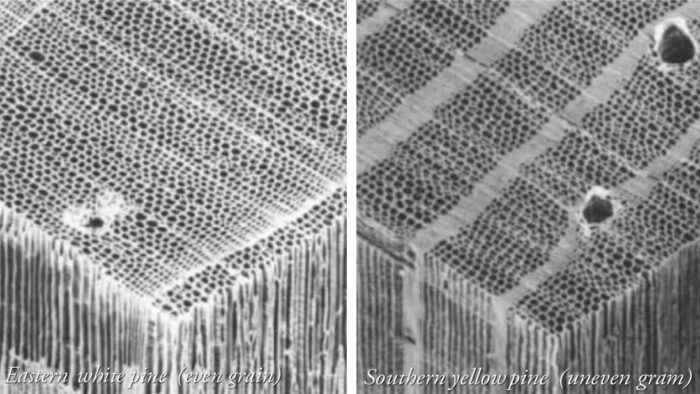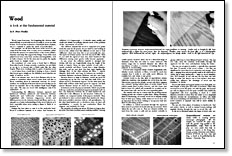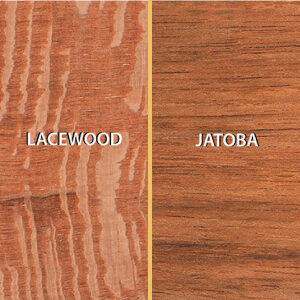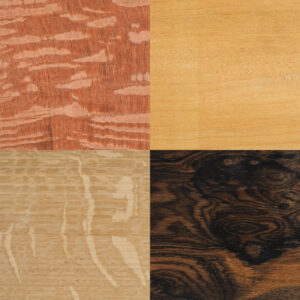
Synopsis: Wood technologist R. Bruce Hoadley offers cases that illustrate why it’s important to remember where wood comes from and to know something about its anatomical structure. Understanding the difference between sapwood and heartwood, between earlywood and latewood, hardwoods and softwoods, ray cells and longitudinal cells, and so on, gives us a better understanding of why wood behaves as it does, especially when we’re trying to shape it, finish it, or preserve it. Hoadley explains some of these terms and gives a basic overview of the material in this article.
Wood comes from trees. Not forgetting this obvious statement will help us work with wood as it really is, not as we wish it were. For wood has evolved as a functional tissue of plants, not as a material to satisfy the needs of woodworkers.
For example, we all know that most of the wood we use comes from the trunk, bole, or stem, as it is sometimes called, not from the unseen root system below or the crown of limbs, branches and twigs that support the foliage. Some of the most prized wood does come from crotches and irregularities, such as burls or knees, but for the most part we prefer the regular grain found in straight trunks.
But sometimes we come across a board that is different from other boards. It warps severely, or pinches our saw blade as we rip it, or doesn’t take a finish quite like the other boards. What we’re working with is a piece of reaction wood — wood taken from a trunk that is leaning or from a branch that doesn’t grow straight up (by definition most branches are made of reaction wood).
This is an extreme case, but it does illustrate why it’s important to remember where wood comes from and also to know something about its anatomical structure. As woodworkers, we usually know far more about our tools than we do about our materials. But as the architect Frank Lloyd Wright once said, “We may use wood with intelligence only if we understand it.”
Understanding the difference between sapwood and heartwood, between earlywood and latewood, between “hardwoods” and “softwoods,” between ray cells and longitudinal cells, between ring-porous woods and diffuse-porous woods, between vessels and fibers, and so on, may give us a better understanding of why wood behaves as it does, especially when we’re trying to shape it, finish it, or preserve it.
Perhaps the best place to start is at the molecular level. Wood is a cellulose material, as is cotton. And because it’s cellulosic, it is hygroscopic — it absorbs water readily and swells and shrinks accordingly (therein much of the problem of the “movement of wood”).

The cellulose material that wood is composed of is pretty much the same for all species. It’s not until we start looking at wood at the cellular level that different woods start to look “different.” (And even here this is not necessarily the case. The sapwood of many species can look very much alike. Then it’s not until the sapwood turns into dead heartwood that differences among some species really become apparent).
In any event, the cellulosic material is arranged into tubular cells that run longitudinally along the length of the trunk or branch. There are three varieties of such cells — vessels, tracheids, and fibers. Vessels have a large diameter, thin walls, and are very short (but they stack together like drainage tiles). At the other extreme are fibers — narrow diameter, thick walls, and long. In between are tracheids — moderate diameter, moderate thickness, and also very long.
Because they’re so large in diameter, vessels are good for conducting sap up the tree, but their thin walls don’t contribute much to mechanical support. On the other hand, the thick walls of fibers make them good for support, but their narrow diameter doesn’t do much for sap conduction.
In between are the all-purpose tracheids, which can provide both sap conduction and physical support moderately well. In fact, one distinction between the so-called hardwoods and softwoods is this difference in cell structure. Softwoods, or conifers, are composed mainly of all-purpose tracheids. They are believed to have evolved earlier than hardwoods. Hence their more primitive structure, with no cell specialization. On the other hand hardwoods, or deciduous trees, do have cell specialization — vessels for sap conduction, fibers for support, and tracheids for both.
The tracheids of conifers are about 100 times as long as they are wide. Thus their excellent paper-making qualities. Among conifer species, however, there can be a three-fold range of diameters, from fine red cedar to coarse redwood. This texture range due to tracheid diameter also affects the smoothness of surface or evenness of staining that can be achieved in woodworking.
If wood were composed strictly of these longitudinal cells, whether vessels, tracheids, or fibers, it would be much less complex than it really is, and really much different, for consider how and where a tree grows.
Growth occurs in the thin layer of reproductive tissues, called the cambium, that separates the wood from the bark. This tubular reproductive sheath, several cells thick, migrates ever outward, leaving behind layers of newly formed wood (which remain fixed in place forever), and also forms new bark in front of it (which will eventually be crowded out by the newer bark cells, and by the ever-expanding girth).
The cambial cells vary in content with the growing seasons. During growth the content is quite fluid; during dormancy there is a thickening. As a result, wood cut in summer usually loses its bark upon drying, while winter-cut wood does not, an important fact for those wishing to incorporate bark into their woodworking projects.
In addition to vertical movement through the sapwood, there must be provision for horizontal sap movement. That’s where the ray cells come in. They are oriented radially outward from the center or pith and are stacked vertically in groups called rays to form flattened bands of tissue. The rays not only carry the nutrients horizontally through the sapwood, but also store carbohydrates during the winter.
The rays are not great in number — typically they represent less than 10 percent of the wood volume — but they are significant for more than food conduction and storage. Their size — ranging from microscopically small in all softwoods to visibly big in many hardwoods — helps in wood identification. (For example, in red oak rays are less than one inch high; in white oak, they’re one to four inches.) And structurally they influence the shrinkage of wood and the formation of checks.
Wood cells shrink and expand mainly across their girth, not their length, as they give off or take on moisture. That’s why wood moves across the grain, not with the grain. But because ray cells are aligned across the grain (radially) they inhibit the longitudinal cells from expanding as much in a radial direction (towards or away from the center) as in a tangential direction (around the circumference). In effect, the radial cells act as restraining rods imbedded in the wood. That’s why wood contracts or expands only half as much radially as tangentially.
For the full article, download the PDF below:
Fine Woodworking Recommended Products

DeWalt 735X Planer

Ridgid R4331 Planer

AnchorSeal Log and Lumber End-Grain Sealer























Log in or create an account to post a comment.
Sign up Log in